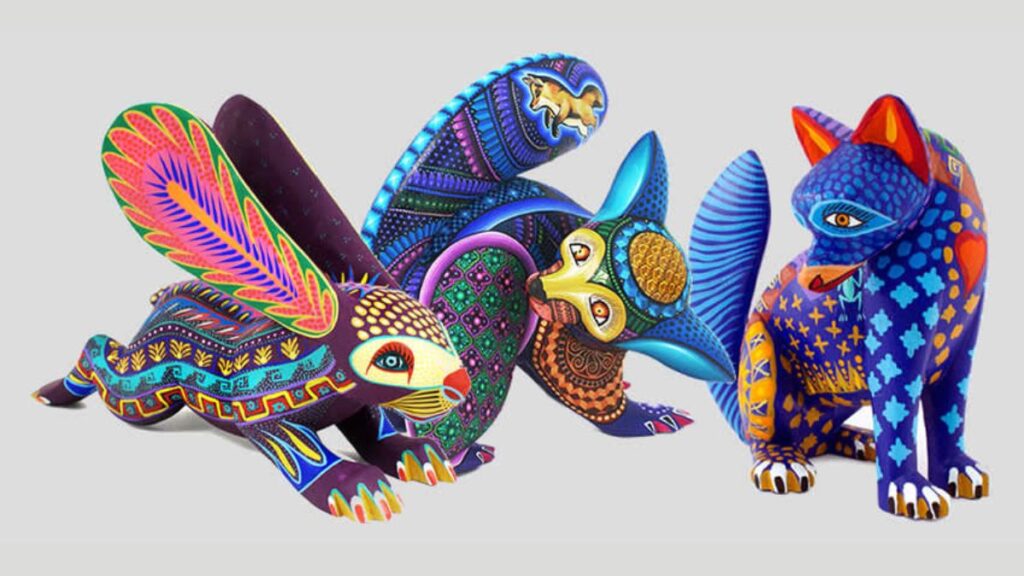In the heartland of Mexico, a riot of colors and fantastical creatures come to life in the form of Alebrijes. These unique handcrafted sculptures are more than just inanimate objects; they are a testament to the rich cultural heritage and artistic brilliance of Mexico. In this article, we will embark on a colorful journey to explore the captivating world of Alebrijes. From their intriguing origins to the skilled artisans who create them, we’ll delve into every facet of these intricate creations.
What Are Alebrijes?
Defining Alebrijes
Alebrijes, pronounced “ah-leh-bree-hehs,” are fantastical Mexican sculptures, often representing imaginary creatures or a blend of different animals. These sculptures are meticulously carved and painted, creating a mesmerizing visual spectacle that captures the essence of Mexican folklore and mythology.
The Origins of Alebrijes
The story of Alebrijes traces its roots to two visionary Mexican artists: Pedro Linares and Manuel Jiménez. In the 1930s, Pedro Linares fell seriously ill and dreamt of a strange place resembling a forest. He saw trees, animals, rocks, clouds, thorns, and other elements that transformed into strange, fantastical creatures. Upon his recovery, Linares began recreating these vivid visions through papier-mâché and wood, thus giving birth to Alebrijes. Manuel Jiménez, another talented artist from the village of Arrazola, later adopted this art form and added his distinctive touch, making Alebrijes even more popular.
The Artistry Behind Alebrijes
Crafting Alebrijes
Creating Alebrijes is a labor-intensive process that requires exceptional skill and dedication. Artisans begin by selecting a suitable piece of wood, often from the copal tree, which is native to Oaxaca. The chosen wood is then carefully carved using traditional hand tools, shaping it into the desired form. This process alone can take several days or even weeks, depending on the complexity of the design.
Painting the Magic
Once the sculpture is carved, it’s meticulously painted with vibrant, eye-catching colors. Alebrijes are known for their intricate patterns and bold hues. Artisans use natural pigments and brushes made from agave fibers to ensure the colors are vivid and long-lasting. The final result is a kaleidoscope of colors that captivates anyone who gazes upon it.
The Symbolism of Alebrijes
Aleb’rijes are more than just decorative sculptures; they carry deep cultural and spiritual significance. In Mexican folklore, they are believed to be spirit guides, protecting individuals on their life journeys. These whimsical creatures serve as a bridge between the natural and supernatural worlds, offering guidance and protection.
The Alebrijes Festival
Each year in Oaxaca, the spirit of Aleb’rijes comes alive in a grand celebration known as the “Night of the Radishes” or “Noche de Rábanos.” During this event, artisans showcase their most exquisite Aleb’rijes made from radishes, showcasing the versatility of this art form and its integration into local traditions.
Collecting Alebrijes
Ale’brijes have gained international acclaim, making them highly sought-after collectibles. They are not only cherished for their artistic value but also for their cultural significance. Collectors from around the world avidly seek these handcrafted masterpieces to adorn their homes and collections.
Conclusion
In a world that often moves too fast, Aleb’rijes remind us to pause, appreciate the artistry of craftsmanship, and embrace the fantastical. These unique sculptures are a testament to human creativity and the enduring connection between art and culture. As you explore the vibrant world of Alebrijes, you’ll find yourself enchanted by the colors, craftsmanship, and stories they bring to life.
FAQs
Q: Are Alebrijes only found in Mexico?
No, Aleb’rijes originated in Mexico, but their popularity has spread worldwide, and you can find them in art galleries and collections globally.
Q: What are the most common materials used to make Alebrijes?
The most common materials are wood, papier-mâché, and sometimes, metal.
Q: Do Alebrijes have specific meanings based on their designs?
Yes, often, the designs of Aleb’rijes carry specific meanings or are inspired by Mexican mythology and folklore.
Q: Are Alebrijes made by individual artists or in workshops?
Both. While some artists create Aleb’rijes individually, there are also workshops where artisans collaborate on larger pieces.
Q: Can I purchase authentic Alebrijes online?
Yes, you can find authentic Aleb’rijes online, but it’s essential to buy from reputable sources to ensure their authenticity and quality.







